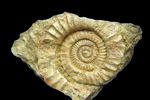Fossils Replicas
Fossils Replicas: Ammonite Hophites, Annularia, Clamites Tree Trunk, Cycad Frond, Cycad Stump, Eremotherium Mirabile, Giant ammonite, Gingko Leaf, Lepidodendron bark, Lepidodendron Foliage, Lepidodendron root, Mylacris SP Roach, Seed Fern Foliage, Sigilaria Lycopod bark.
Fossils (from Latin fossus, literally "having been dug up") are the mineralized or otherwise preserved remains or traces (such as footprints) of animals, plants, and other organisms. The totality of fossils, both discovered and undiscovered, and their placement in fossiliferous (fossil-containing) rock formations and sedimentary layers (strata) is known as the fossil record. The study of fossils across geological time, how they were formed, and the evolutionary relationships between taxa (phylogeny) are some of the most important functions of the science of paleontology.
Fossils vary in size from microscopic, such as single cells, to gigantic, such as dinosaurs. A fossil normally preserves only a portion of the deceased organism, usually that portion that was partially mineralized during life, such as the bones and teeth of vertebrates, or the chitinous exoskeletons of invertebrates. Preservation of soft tissues is exquisitely rare in the fossil record. Fossils may also consist of the marks left behind by the organism while it was alive, such as the footprint or faeces (feces) (coprolites) of a reptile. These types of fossil are called trace fossils (or ichnofossils), as opposed to body fossils. Finally, past life leaves some markers that cannot be seen but can be detected in the form of biochemical signals; these are known as chemofossils or biomarkers.
Fossils (from Latin fossus, literally "having been dug up") are the mineralized or otherwise preserved remains or traces (such as footprints) of animals, plants, and other organisms. The totality of fossils, both discovered and undiscovered, and their placement in fossiliferous (fossil-containing) rock formations and sedimentary layers (strata) is known as the fossil record. The study of fossils across geological time, how they were formed, and the evolutionary relationships between taxa (phylogeny) are some of the most important functions of the science of paleontology.
Fossils vary in size from microscopic, such as single cells, to gigantic, such as dinosaurs. A fossil normally preserves only a portion of the deceased organism, usually that portion that was partially mineralized during life, such as the bones and teeth of vertebrates, or the chitinous exoskeletons of invertebrates. Preservation of soft tissues is exquisitely rare in the fossil record. Fossils may also consist of the marks left behind by the organism while it was alive, such as the footprint or faeces (feces) (coprolites) of a reptile. These types of fossil are called trace fossils (or ichnofossils), as opposed to body fossils. Finally, past life leaves some markers that cannot be seen but can be detected in the form of biochemical signals; these are known as chemofossils or biomarkers.































